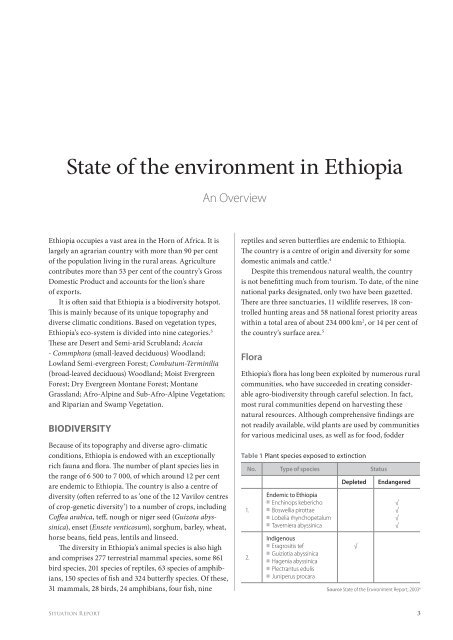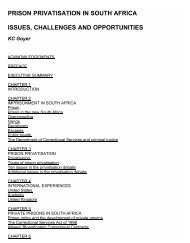4466 Environmental Crimes in Ethiopia.indd
4466 Environmental Crimes in Ethiopia.indd
4466 Environmental Crimes in Ethiopia.indd
Create successful ePaper yourself
Turn your PDF publications into a flip-book with our unique Google optimized e-Paper software.
State of the environment <strong>in</strong> <strong>Ethiopia</strong><br />
An Overview<br />
<strong>Ethiopia</strong> occupies a vast area <strong>in</strong> the Horn of Africa. It is<br />
largely an agrarian country with more than 90 per cent<br />
of the population liv<strong>in</strong>g <strong>in</strong> the rural areas. Agriculture<br />
contributes more than 53 per cent of the country’s Gross<br />
Domestic Product and accounts for the lion’s share<br />
of exports.<br />
It is often said that <strong>Ethiopia</strong> is a biodiversity hotspot.<br />
This is ma<strong>in</strong>ly because of its unique topography and<br />
diverse climatic conditions. Based on vegetation types,<br />
<strong>Ethiopia</strong>’s eco-system is divided <strong>in</strong>to n<strong>in</strong>e categories. 3<br />
These are Desert and Semi-arid Scrubland; Acacia<br />
- Commphora (small-leaved deciduous) Woodland;<br />
Lowland Semi-evergreen Forest; Combutum-Term<strong>in</strong>ilia<br />
(broad-leaved deciduous) Woodland; Moist Evergreen<br />
Forest; Dry Evergreen Montane Forest; Montane<br />
Grassland; Afro-Alp<strong>in</strong>e and Sub-Afro-Alp<strong>in</strong>e Vegetation;<br />
and Riparian and Swamp Vegetation.<br />
BIODIVERSITY<br />
Because of its topography and diverse agro-climatic<br />
conditions, <strong>Ethiopia</strong> is endowed with an exceptionally<br />
rich fauna and flora. The number of plant species lies <strong>in</strong><br />
the range of 6 500 to 7 000, of which around 12 per cent<br />
are endemic to <strong>Ethiopia</strong>. The country is also a centre of<br />
diversity (often referred to as ’one of the 12 Vavilov centres<br />
of crop-genetic diversity’) to a number of crops, <strong>in</strong>clud<strong>in</strong>g<br />
Coffea arabica, teff, nough or niger seed (Guizota abyss<strong>in</strong>ica),<br />
enset (Ensete venticosum), sorghum, barley, wheat,<br />
horse beans, field peas, lentils and l<strong>in</strong>seed.<br />
The diversity <strong>in</strong> <strong>Ethiopia</strong>’s animal species is also high<br />
and comprises 277 terrestrial mammal species, some 861<br />
bird species, 201 species of reptiles, 63 species of amphibians,<br />
150 species of fish and 324 butterfly species. Of these,<br />
31 mammals, 28 birds, 24 amphibians, four fish, n<strong>in</strong>e<br />
reptiles and seven butterflies are endemic to <strong>Ethiopia</strong>.<br />
The country is a centre of orig<strong>in</strong> and diversity for some<br />
domestic animals and cattle. 4<br />
Despite this tremendous natural wealth, the country<br />
is not benefitt<strong>in</strong>g much from tourism. To date, of the n<strong>in</strong>e<br />
national parks designated, only two have been gazetted.<br />
There are three sanctuaries, 11 wildlife reserves, 18 controlled<br />
hunt<strong>in</strong>g areas and 58 national forest priority areas<br />
with<strong>in</strong> a total area of about 234 000 km 2 , or 14 per cent of<br />
the country’s surface area. 5<br />
Flora<br />
<strong>Ethiopia</strong>’s flora has long been exploited by numerous rural<br />
communities, who have succeeded <strong>in</strong> creat<strong>in</strong>g considerable<br />
agro-biodiversity through careful selection. In fact,<br />
most rural communities depend on harvest<strong>in</strong>g these<br />
natural resources. Although comprehensive f<strong>in</strong>d<strong>in</strong>gs are<br />
not readily available, wild plants are used by communities<br />
for various medic<strong>in</strong>al uses, as well as for food, fodder<br />
Table 1 Plant species exposed to ext<strong>in</strong>ction<br />
No. Type of species Status<br />
1.<br />
2.<br />
Endemic to <strong>Ethiopia</strong><br />
■ Ench<strong>in</strong>ops kebericho<br />
■ Boswellia pirottae<br />
■ Lobelia rhynchopetalum<br />
■ Taverniera abyss<strong>in</strong>ica<br />
Indigenous<br />
■ Eragrositis tef<br />
■ Guiziotia abyss<strong>in</strong>ica<br />
■ Hagenia abyss<strong>in</strong>ica<br />
■ Plectrantus edulis<br />
■ Juniperus procara<br />
Depleted<br />
√<br />
Endangered<br />
√<br />
√<br />
√<br />
√<br />
Source State of the Environment Report, 2003 6<br />
Situation Report 3
















